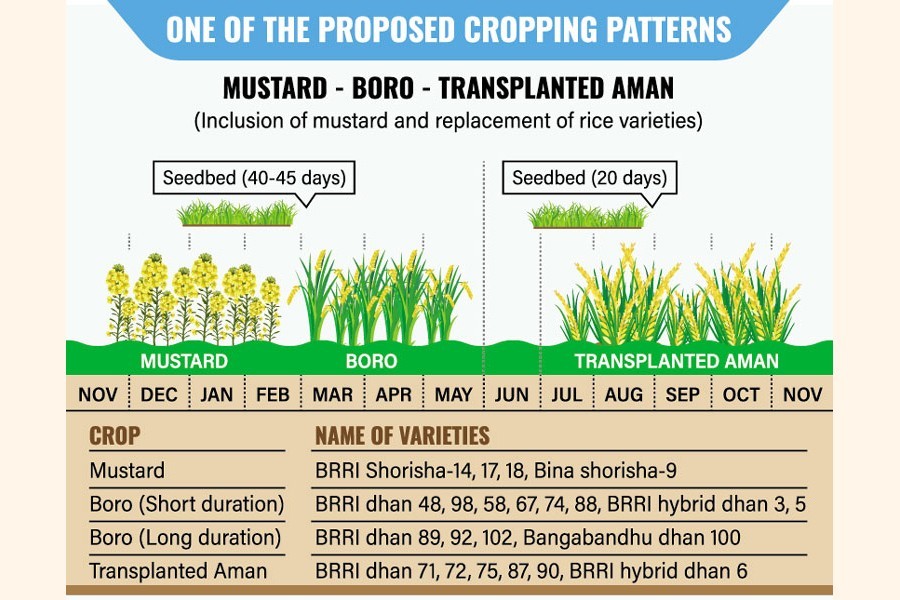Use of new cropping patterns by FY '25
Rice output to rise 3.3m tonnes, edible oil import to squeeze 50pc

Published :
Updated :

Bangladesh is going to appropriate new cropping patterns for its agro-ecological zones to boost rice output by 3.3-million tonnes and cut edible-oil imports by 50 per cent within 2025.
New methods will include oilseeds as newly developed high-yielding and hybrid varieties replace conventional ones following changing climatic conditions and a squeeze in arable-land area.
Experts said this at a national-level workshop styled 'Inclusion of oilseeds in conventional cropping systems and increasing production of high-yielding varieties of rice crops' at Krishibid Institution Bangladesh on Thursday.
The event was organised by the Bangladesh Rice Research Institute (BRRI) in association with the Department of Agricultural Extension (DAE).
BRRI head of rice farming division Dr Md Ibrahim presented a keynote. DAE director Md Habibur Rahman Chowdhury also presented a paper on the same.
Mr Ibrahim proposed 16 different cropping patterns for different regions based on their land pattern, climate-change vulnerability, availability of modern crop varieties and other issues.
On the other hand, Mr Habibur said cultivation of high-yielding and hybrid varieties in place of conventional varieties like BRRI dhan 28, 29, 49 and 11 in Boro, Aman and Aus seasons will boost rice production by 3.236-million tonnes within fiscal year (FY) 2024-25.
BRRI dhan 28, 29, 49 and 11 and other conventional varieties could be replaced by high-yielding varieties, including BRRI dhan 89 and 92, BRRI hybrid dhan 5, 3 and 6.
"If we could replace those as per our expansion plan, Boro season productivity per hectare by FY25 will be 4.60 tonnes from 4.0 tonnes now," said Mr Habibur.
As a result, the total Boro production could be raised by 1.438-million tonnes within the time frame. Similarly, Aman productivity per hectare might be increased from 2.95 tonnes to 3.44 tonnes through replacing the varieties.
Aman production in this way could be increased by 1.463-million tonnes.
By adopting the same in Aus season, the output could be raised by 0.36-million tonnes further, according to the DAE paper.
Meanwhile, Mr Ibrahim said productivity could be increased through varietal development and replacement of the developed varieties with traditional crops. Development of production systems, bringing fallow land under cultivation and changing conventional cropping systems will increase the production of rice, oilseed and pulses.
"Varietal development can only help us adopt new cropping patterns as we need short-duration and potential varieties for diverse cropping areas."
Apart from rice, the proposed cropping patterns focus on increased production of oilseed crops like mustard, groundnut, sunflower, sesame and soybean.
Agriculture minister Dr Muhammad Abdur Razzaque said researchers and extension workers should work hand in hand with farmers to adopt the new patterns taking into account climate challenges.
"If we can virtualise the new methods," he said, "we may cut edible oil import by 50 per cent."
It is unbelievable that the country imports edible oil worth $2.0 billion when its overall export is $50 billion per annum, said Mr Razzaque.
He admitted that rice prices in the country have increased amid a hike in wheat flour prices.
Additionally, Bangladesh is also feeding 1.5-million Rohingya nationals from Myanmar with its own rice, thus putting pressure on overall supply, cited the minister.
What is more, the ongoing Covid-19 and Russia-Ukraine war have placed further pressure on the economy.
Despite all odds, nobody in the country is starving amid the essential supply and safety-net initiatives of the government, added Mr Razzaque.
Apart from raising rice production, he said, new cropping methods would help the country produce more than 3.0-million tonnes of oilseed within FY25.
According to the BRRI paper, the inclusion of developed rice varieties can help the country to have a surplus 6.5-million tonnes by 2050 when overall production reaches 60.9-million tonnes.
tonmoy.wardad@gmail.com


 For all latest news, follow The Financial Express Google News channel.
For all latest news, follow The Financial Express Google News channel.